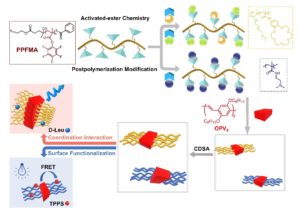Xiang et al. developed a facile and versatile platform for preparing uniform π-conjugated-polymer-based nanofibers (CPNFs) with controlled length and varying functionalities.
The development of controlled π-conjugated polymer nanofibers (CPNFs) represents a significant breakthrough in polymer chemistry due to their wide-ranging applications in electronics, nanomedicine, and catalysis. However, achieving precise control over their length, composition, and surface properties has been a persistent challenge.
To address this, Xiang et al. developed a novel and efficient platform combining activated-ester/amine chemistry with the self-seeding approach of living crystallization-driven self-assembly (CDSA). This method enables the fabrication of uniform CPNFs with controllable dimensions and diverse functionalities. Using poly(pentafluorophenyl methacrylate) (PPFMA) as a precursor, the authors synthesized corona-forming polymers featuring 18-crown-6 (18C6) and dimethylamino (DMA) functionalities, which were subsequently coupled with an oligo(p-phenylenevinylene) (OPV5) π-conjugated core. This approach facilitated the creation of diblock copolymers capable of forming monodisperse fiber-like micelles through self-seeding. By systematically employing the annealing conditions, uniform fiber-like micelles with tunable and precise length were achieved. Furthermore, the functionality of the corona-forming segments was exploited for a variety of applications. For instance, the 18C6 coronas were complexed with sodium and potassium ions, significantly enhancing the stability of seed micelles. The incorporation of chiral amines introduced helicity to the fibers, as evidenced by circular dichroism analysis. The versatility of the platform was further demonstrated through the functionalization of DMA-containing coronas with metal ions, nanoparticles, and porphyrins. These modifications not only enriched the structural diversity of the fibers but also expanded their potential in catalysis and photonic applications.
In summary, this work provides a facile and efficient platform for constructing π-conjugated nanofibers with precise dimensional and functional control. This work opens a facile and general platform for generating distinct CPNFs for diverse applications ranging from nanomedicine to (photo)catalysis.
Tips/comments directly from the authors:
- Versatile precursor chemistry enabled efficient post-polymerization modifications, allowing the seamless introduction of diverse functional groups into the shell of nanostructures.
- Combined with the precise control over nanofiber length and morphology offered by living CDSA, this methodology exemplifies the possibility of controlled self-assembly for precision preparation of π-conjugated nanostructures with diverse functionalities and designed architecture.
Citation of the paper: A facile and versatile platform for preparing uniform π-conjugated nanofibers with controlled length and varying shells, Polym. Chem., 2024, 15, 4231-4243, DOI: 10.1039/d4py00979g
Link to the paper: https://pubs.rsc.org/en/Content/ArticleLanding/2024/PY/D4PY00979G

Dr. Kelly Velonia is an Advisory Board Member and a Web Writer for Polymer Chemistry. She joined the Department of Materials Science and Technology at the University of Crete in 2007. Research in her group focuses on the synthesis and applications of bioconjugates and biopolymers. You can follow Kelly on twitter @KellyVelonia.











